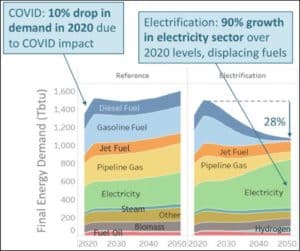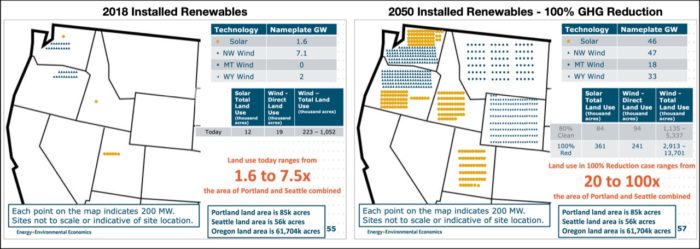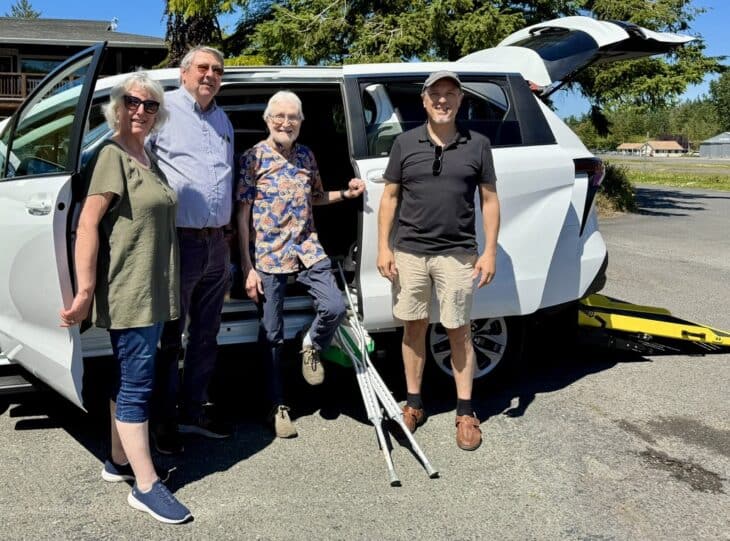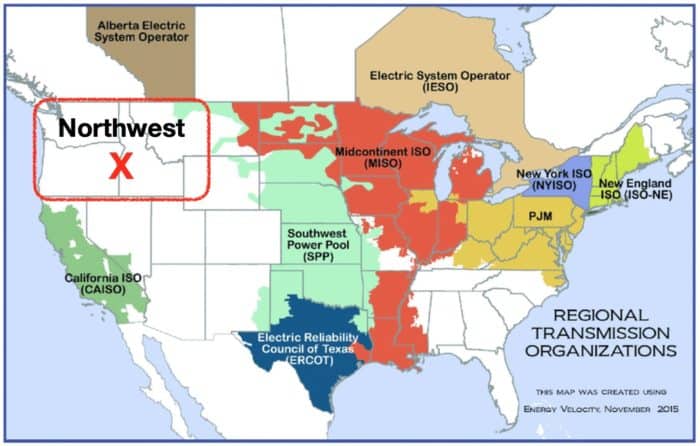Quick Fact – Simpson Proposal and the Northwest Energy Evolution
Washington State and the Whitehouse have been evaluating what it takes to replace the Lower Snake River Dams (LSRD). Progress is being made, albeit slowly. This update looks at recent action taken by Washington in Senate Bill 5187 to fund a detailed analysis of what it would take to replace the LSRD while ensuring continued reliable, clean, affordable energy for the region.
For background, see the earlier sections, posted last year, following this update.
November 2023 Update
Following 2022 State and Whitehouse LSRD studies, the Washington legislature, in May 2023, allocated $2 million for an independent study to deepen understanding of what electricity generation, transmission, efficiency, and storage systems would be sufficient to offset LSRD energy production.
The replacement portfolio must diversify and improve resilience, maintain the reliability and adequacy of the electric power system, and meet the Clean Energy Transformation Act (CETA) net-zero emissions standards.
The devil is in the details, and the state requires the development of distinct scenarios that examine different potential cost and timeline potentials for the development and implementation of identified generation and transmission needs and options, including planning, permitting, design, and construction, including relevant federal authorities, consistent with the statutory and regulatory requirements of the CETA.
This is a good start. OPALCO has advised the state to pay careful attention to the land-intensive nature of solar and wind power. And the intermittent nature of solar and wind can lead to weeks of gray windless days that would require massive amounts of storage to ensure reliable, uninterrupted power, especially during winter cold snaps, when the LSRD power generation is most critical. Given that, the Senate bill requires analysis of expected trends and potential outcomes for electricity demand, generation, and storage technologies development, land use and land use constraints, and cost through 2050.
OPALCO has also warned of emerging Resource Adequacy challenges to regional energy reliability, as legacy fossil-fueled generation resources are rapidly decommissioned. The Senate Bill requires the development of a resource portfolio approach in which a combination of commercially available generating resources, energy efficiency, conservation, and demand response programs, transmission resources, and other programs and resources would be necessary prerequisites to replace the power and grid reliability services otherwise provided by the LSRD. They also want to see the time frame needed to put those resources into operation. This would include the Identification of generation and transmission siting options consistent with the overall replacement resource portfolio.
Importantly, there are specific actions aimed at maintaining system reliability and affordability, especially for overburdened communities.
Learn More:
Senate Bill 5187 (pages 95, 96, and 97)
https://lawfilesext.leg.wa.gov/biennium/2023-24/Pdf/Bills/Session Laws/Senate/5187-S.SL.pdf#page=1
BPA Lower Snake River Dams Power Replacement Study
https://www.whitehouse.gov/wp-content/uploads/2022/07/E3-BPA-LSR-Dams-Report.pdf
Lower Snake River Dams: Benefit Replacement Report
Recommendations of Governor Inslee and Senator Murray following the Conclusion of the Joint Federal-State Process on Salmon Recovery
https://governor.wa.gov/sites/default/files/2022-11/Murray-Inslee Process Recommendations.pdf
The Simpson Proposal
- US Rep. Mike Simpson of Idaho (R) has offered a constructive proposal for breaching the Lower Snake river dams (LSRD). OPALCO, PNGC, and the Washington Rural Electric Cooperative Association (WRECA) appreciate Rep. Simpson’s efforts in developing a framework (Simpson Wall 3.0) for ending the salmon/dam debate with goals of saving the salmon, breaching the Lower Snake River Dams (LSRD) and providing financial incentives to everyone harmed by allowing the LSRDs to be breached. WRECA members are in favor of ending the litigation over salmon and the dams on the Federal Columbia River System.
- Rep. Simpson recognizes the value of the LSRD and proposes $34 billion to compensate stakeholders – environmental groups, BPA, tribes, utilities. transposition, recreation, rate payers, etc.
- His proposal is a general concept, not a plan. OPALCO sees Rep. Simpson as cultivating a regional conversation about a new vision for the Northwest.
- OPALCO supports the recent joint statement of all four Democratic senators from Washington and Oregon: “All communities in the Columbia River Basin and beyond should be heard in efforts to recover the Northwest’s iconic salmon runs while ensuring economic vitality of the region. Any process needs to balance the needs of communities in the Columbia River Basin, be transparent, be driven by stakeholders and follow the science.”
- As with any proposal of this magnitude, OPALCO supports the call from The Public Power Council to perform a thorough analysis of the Simpson proposal.
Texas and California rolling blackouts are harbingers of our climate disrupted future
Over the past few years, action on mitigating climate disruption has accelerated:
- Global carbon emissions have increased by a factor of 3.3 since 1960 , spiking atmospheric CO2 to dangerous levels never seen in over 400,000 years of planetary history.
- As many as one million species are now at risk of extinction, many within decades.
- Oceans have been rapidly heating over the past few decades with about half of the increase since 1865 occurring in the past 20 years.
The LSRD is used for irrigation, transportation, recreation, flood control and energy. From an energy perspective, there is a lot of recent development that the Northwest is trying to sort out.
 Washington state just released their 2021 Energy Strategy, which calls for a near doubling of electric load by 2050, and depends on current levels of hydro to firm a vast new portfolio of intermittent wind and solar energy, to rapidly decarbonize the energy sector (chart at right).
Washington state just released their 2021 Energy Strategy, which calls for a near doubling of electric load by 2050, and depends on current levels of hydro to firm a vast new portfolio of intermittent wind and solar energy, to rapidly decarbonize the energy sector (chart at right).- Washington is also rapidly shutting down all coal energy production (3,000 MW), increasing dependance on hydro but reducing the headroom to meet regional load, with forecasts of imminent rolling blackouts similar to what Texas and California are experiencing during extreme weather.
- Hydro provides us with the ability to firm intermittent resources such as solar and wind, when the sun isn’t shining and the wind isn’t blowing. And unlike hydro, current battery storage technology can only provide energy for a limited short term duration.
- Given the above, we need to consider the bigger resource inadequacy issues affecting the Pacific Northwest region in full detail to understand the consequences of the Simpson proposal.
- Washington plans to essentially require the development of a new renewable energy capacity that is double the size of the northwest dam system developed 100 years ago, in an era that has much more stringent environmental and permitting requirements. There is no plan for how to do that while meeting their objectives of an equitable, inclusive, resilient clean energy economy.
- We believe a Manhattan Project style approach to working with stakeholders and thought leaders in DOE and Commerce to problem solve, plan and fund the transition, including establishing an Regional Transmission Organization (RTO), and deepening understanding of options, pros and cons. Below, we highlight a series of issues and actions the Washington energy strategy calls out that could be part of this process.
The Northwest’s Energy Evolution
As Rep. Simpson and stakeholders come together to hash out the details, here are some things we think need clarifying as the Northwest contemplates its evolving energy mix:
- Land for Wind, Solar and Transmission – There are estimates requiring more than one million acres to meet the need (chart below). How much is needed and can permitting meet environmental requirements in a timely way? At what cost?

- Replacement Energy Portfolio – How long will it take to acquire the land, build the transmission corridors and build the wind and solar capacity? At what cost? How will it impact the cost of electricity? Will Montana, Idaho and Wyoming want to build wind and solar and export it to Washington and Oregon, requiring over a million acres of their wild land? What are the impacts on the industry, BPA revenue/expense, firming of renewables, replacement of capacity, decarbonization legislation, siting, permitting?
- Reliable, Affordable, Clean Energy Goals – How will the new energy system meet Washington’s goals for reliable and affordable clean energy?
- Washington’s 2021 Energy Strategy – How will Washington’s plan to double the electric load to support clean transportation and heating be accomplished with reduction of hydro capacity?
- Reducing carbon pollution – How will the Simpson proposal impact the northwest carbon footprint as it reduces low carbon hydro? Will natural gas and other fossil fuels be required to firm intermittent solar and wind power?
- Climate Impact on Salmon Versus LSRD – Global carbon emissions have increased by a factor of 3.3 since 1960, spiking atmospheric CO2 to dangerous levels never seen in over 400,000 years of planetary history. As many as one million species are now at risk of extinction, many within the coming decades. Oceans have been rapidly heating over the past few decades, with about half of the increase since 1865 occurring in the past 20 years. Simpson acknowledges that his proposal may not help the salmon, due to the larger environmental impact of climate change. What is the bigger threat to salmon, the LSRD or climate change? How will removing the LSRD impact decarbonization in the Northwest and land and marine species health?
- Reform and Expand Wholesale Electricity Markets – To avoid Texas/California style blackouts and market price extremes, can the Northwest establish a centralized Regional Transmission Organization (RTO) to replace the current Energy Imbalance Market (EIM)? An RTO provides better coordination for transmission planning, unit commitment (deciding which generators will be available to run) and transmission system use. As solar and wind are deployed at optimal sunny and windy locations, they will be more dispersed and distant. To procure power from distant generators, a utility currently must separately arrange for transmission rights across each separate system used to transport power to its ultimate delivery point. The utility must pay the owner of each transmission system a fee to move power across its system.
- BPA Plans – BPA does NOT have any requirement (or funding or plans) to build more generating capacity or new transmission lines. BPA is obligated to only provide preference customers (such as OPALCO) with their current TIER 1 allocation of the federal hydro system and nothing more. Further, BPA is looking to “maximize the value” of all excess power above TIER 1 load by selling it on the open market to the highest bidder. Contracts are to be renegotiated prior to 2028. How will the Simpson proposal effect the cost of power to OPALCO given the projected doubling of load? How will their approach to pricing be impacted by the Simpson proposal?
In short, this is a massive project. Washington has released its ambitious 2021 Energy Strategy for getting to zero carbon. The strategy forecasts electric load doubling by 2050, driven primarily by the electrification of transportation and heating, and powered by wind, solar and battery resources. Washington plans to essentially require the development of a new renewable energy capacity that is double the size of the northwest dam system (developed 100 years ago), in an era that has much more stringent environmental and permitting requirements. This is like a Manhattan project and an Apollo moon shot ongoing for the next 20 to 30 years.
OPALCO is committed to providing safe, reliable, affordable, climate friendly energy and high performance broadband internet services. Look for regular updates from us as the Simpson team and stakeholders refine the proposal and develop a comprehensive regional plan.



